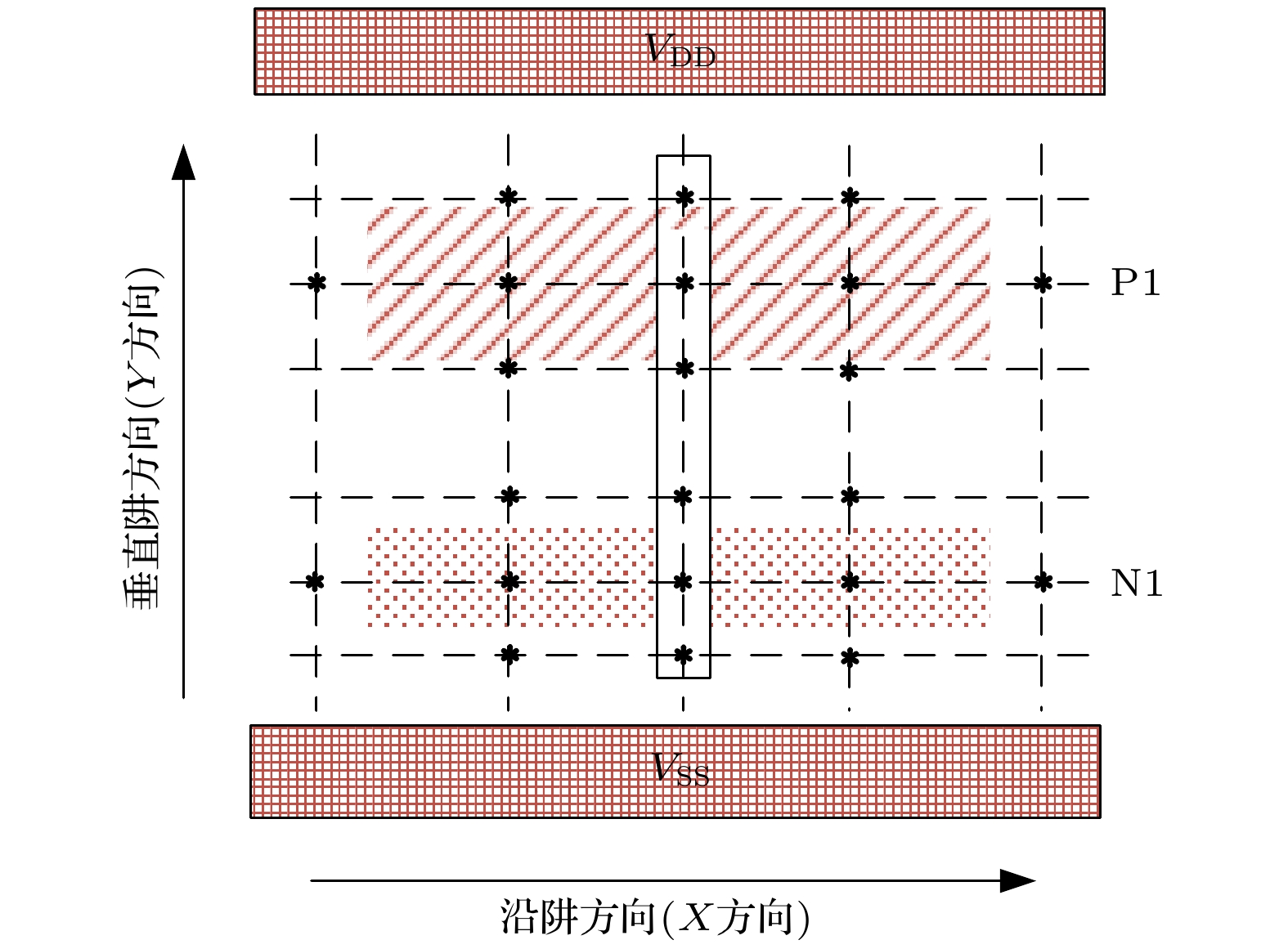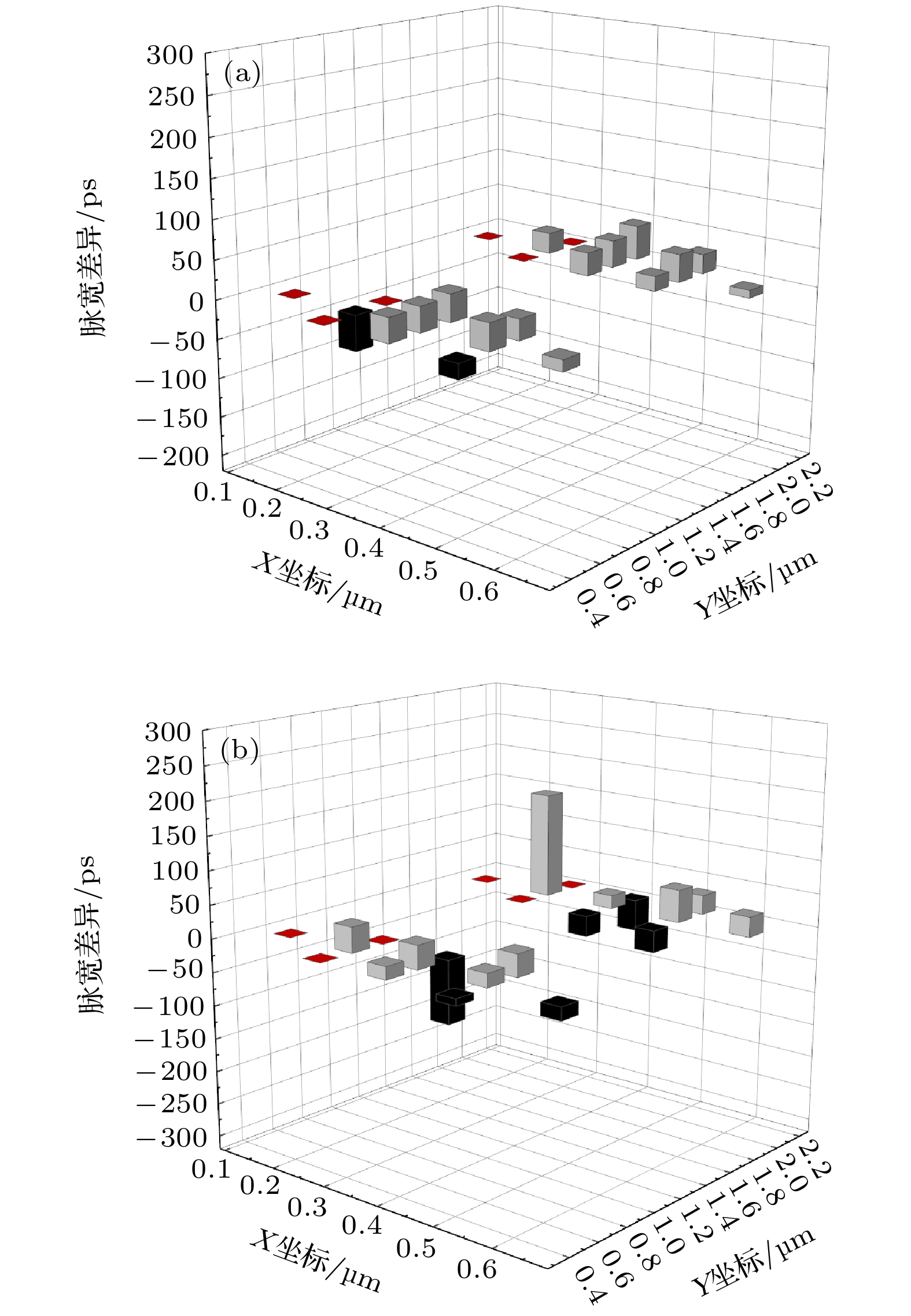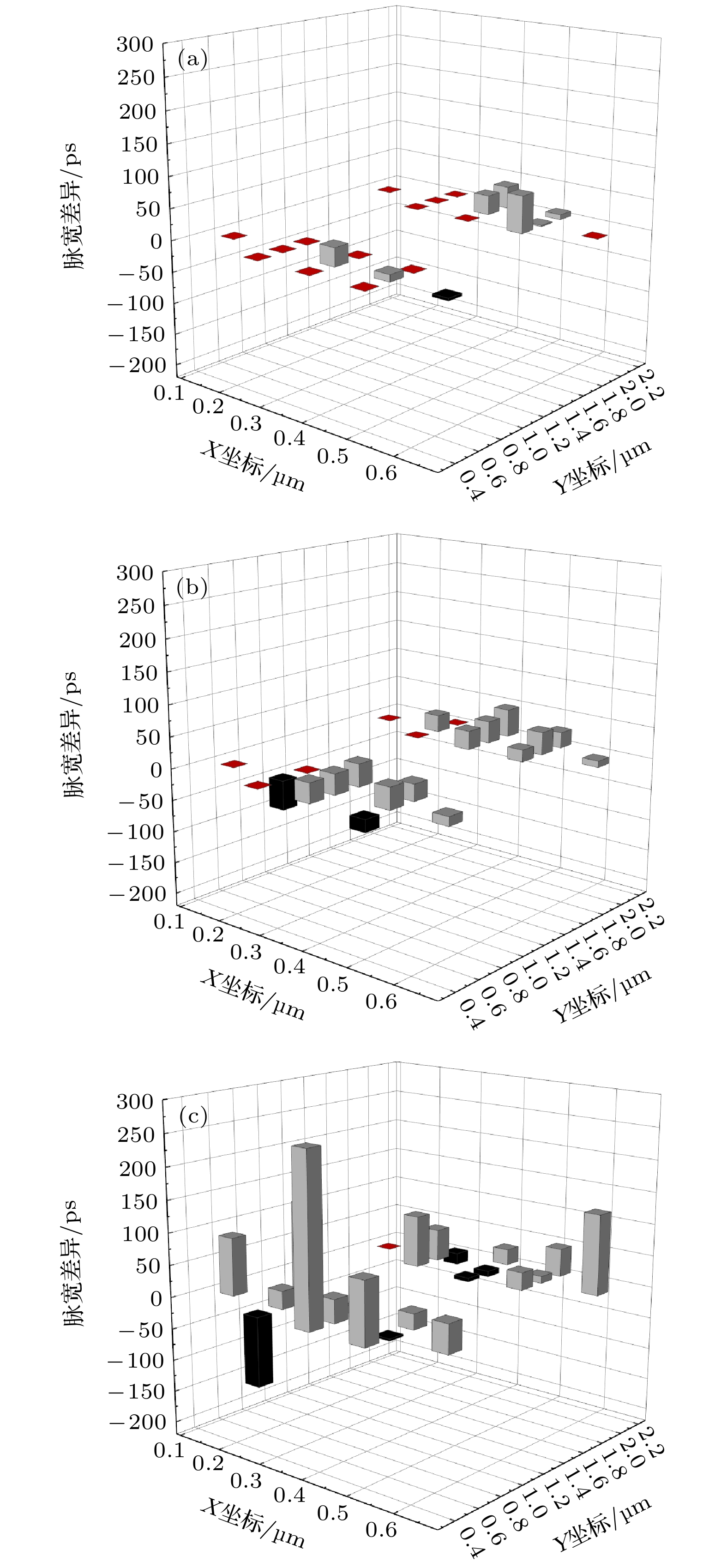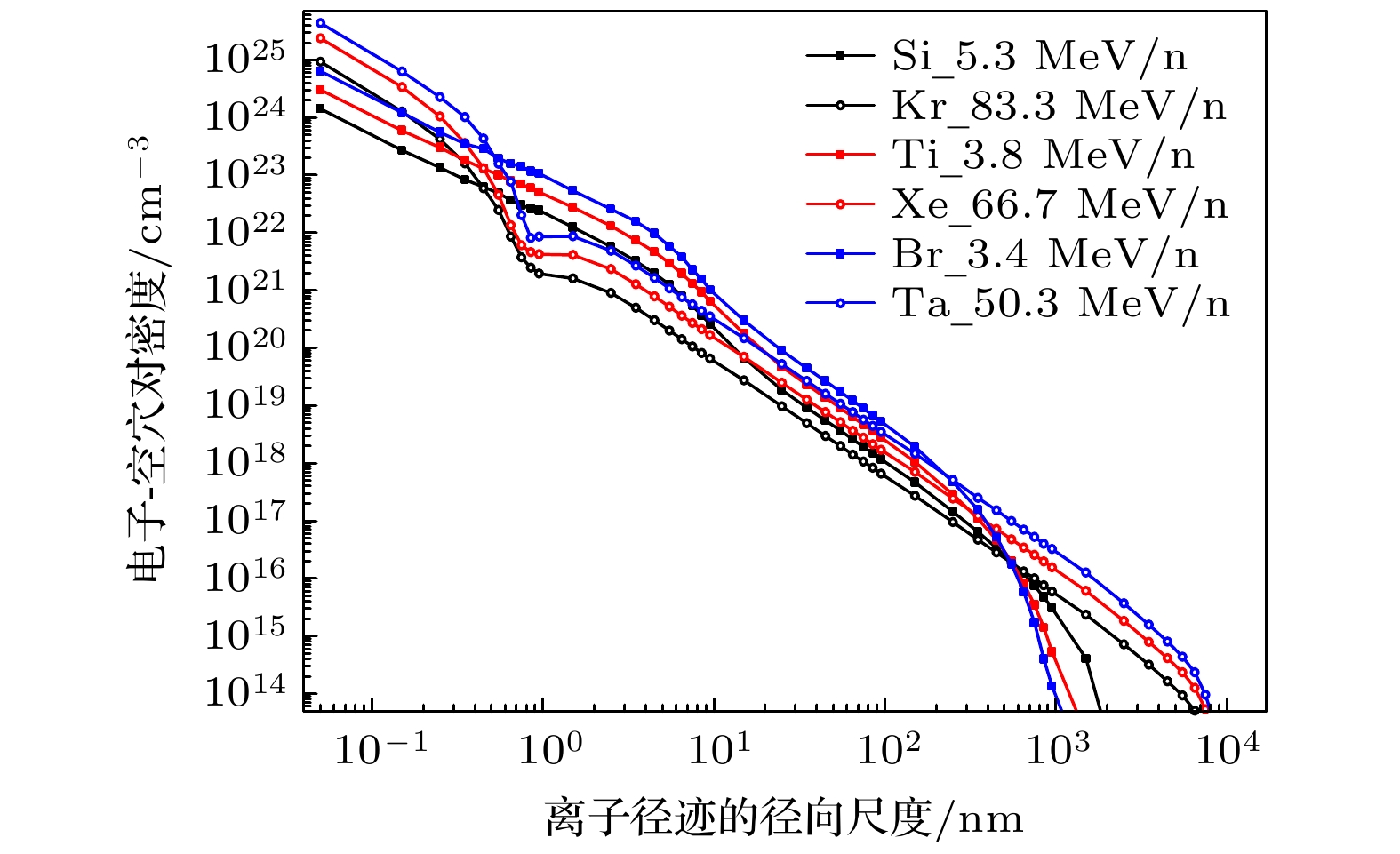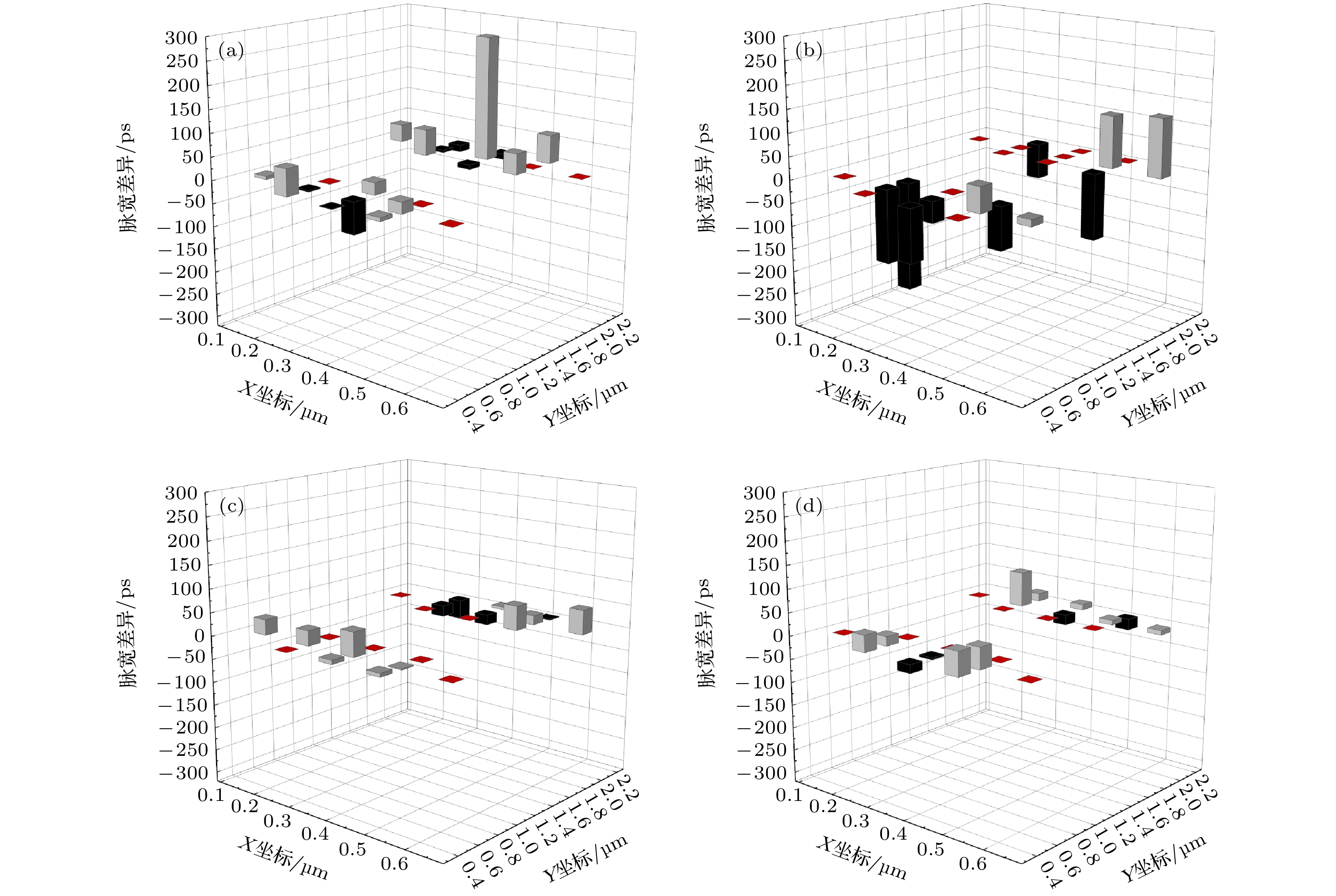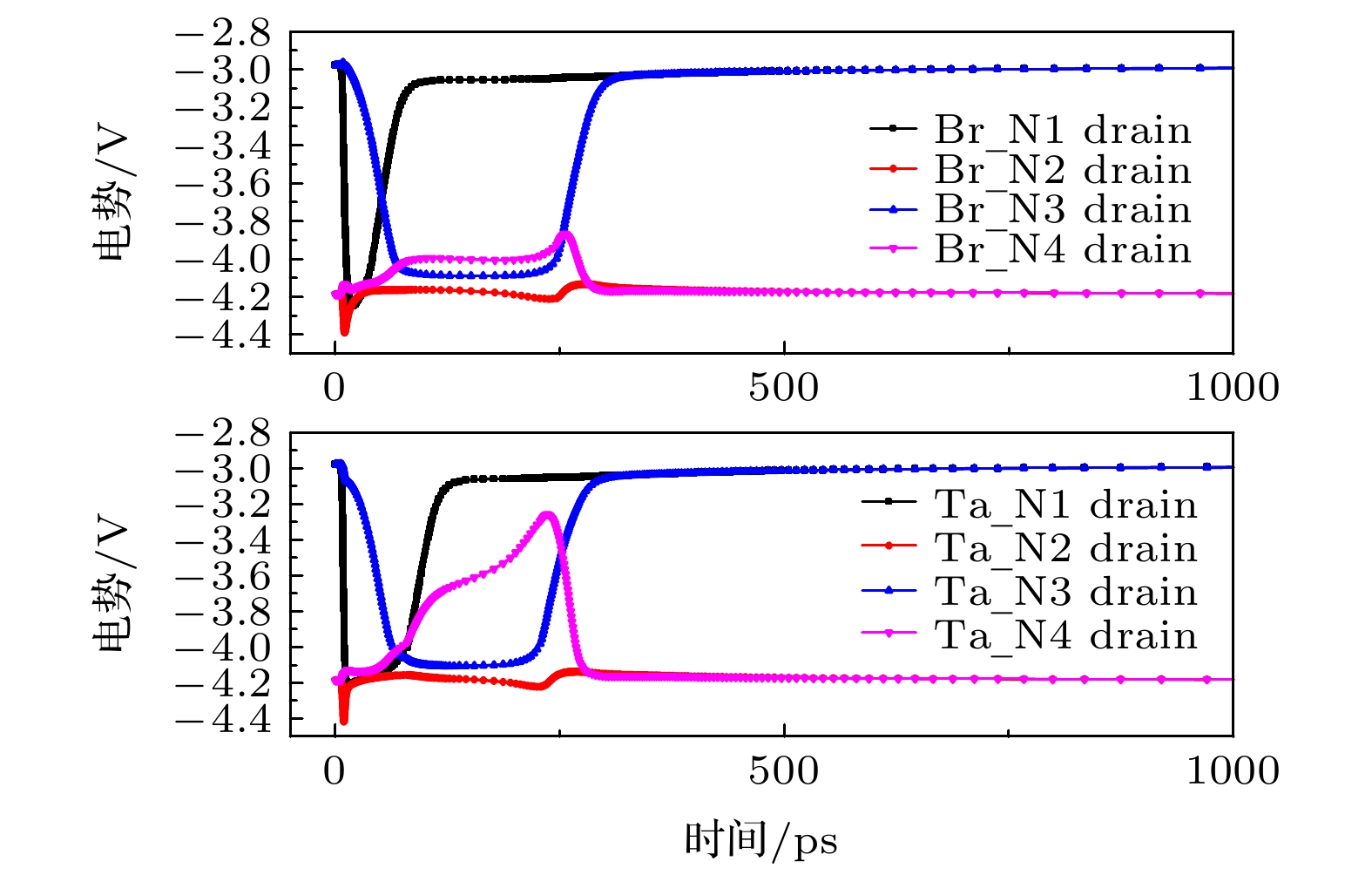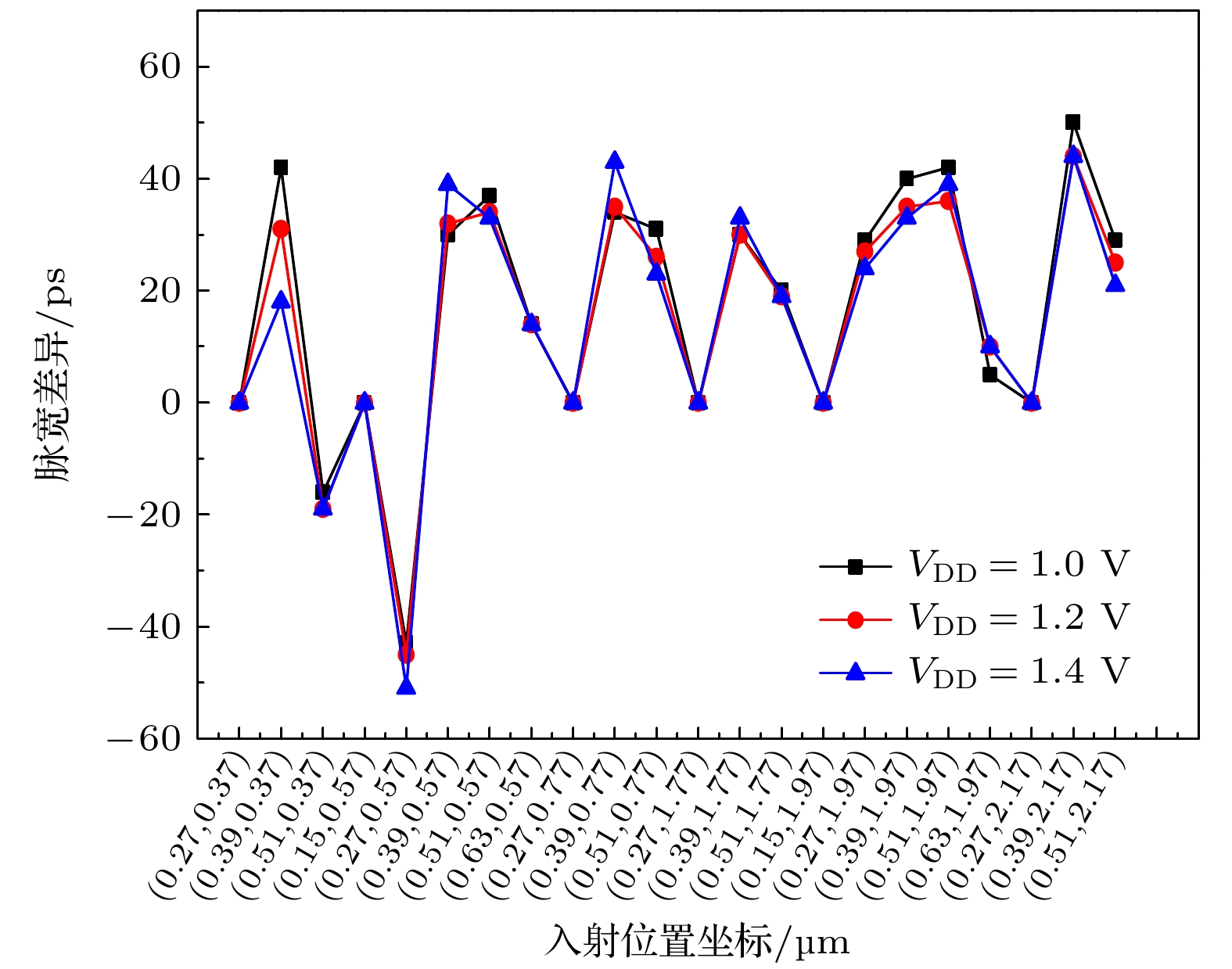-
Ions with the same linear energy transfer (LET) value, but different energies and species have various ion track characteristics, and thus induce different single event transient (SET) responses in combinational logics. As the technology feature size shrinks, this issue continues to be serious. The research of the relationship between ion track characteristics and SETs in the nanometer combinational logic circuits is of great significance for accurately predicting the soft error rates of nanometer devices used in spacecraft. The combinational logic circuit investigated in this paper is a 65 nm bulk silicon complementary metal oxide semiconductor (CMOS) technology inverter chain. The three-dimensional TCAD model of the inverter chain is established, and the particle transport program for the ion track in bulk silicon is developed by Geant4. The track characteristics of high- and low-energy ions (the energy of low-energy ions is less than 10 MeV·n–1, the energy of high-energy ions ranges from tens of MeV·n–1 to hundreds of MeV·n–1) which have the same LET value are compared with each other. Based on the coupled simulation of TCAD and Geant4, the difference in SET pulse widths, induced by ions with the same LET value but different energies, are investigated. It is found that when the energy per nucleon ratio of high-energy ion to low-energy ion increases, the difference in electron-hole pair densities near the center axis of the ion track is more significant, and thus the difference in SET pulse widths is larger. If the energy per nucleon ratio is similar, raising the LET value of ions can increase the difference in electron-hole pair densities on the same radial scale of the ion tracks, and make the SET pulse width difference more obvious. For the high- and low-energy ions with the same LET value, the single event charge generations are different. On the other hand, the change of the ion incident angle results in different charge collections. The coupling of these two factors makes the difference in SET pulse widths dependent on the incident angle of ions. In addition, the influence of ion track characteristics on SET has a weak correlation with the bias voltage of the inverter chain.
-
Keywords:
- single event transients /
- ion track /
- combinational logic circuit /
- linear energy transfer
[1] Stassinopoulos E G, Raymond J P 1988 Proc. IEEE 76 1423
 Google Scholar
Google Scholar
[2] Stapor W J, McDonald P T, Knudson A R 1988 IEEE Trans. Nucl. Sci. 35 1585
 Google Scholar
Google Scholar
[3] Dodd P E, Schwank J R, Shaneyfelt M R 2007 IEEE Trans. Nucl. Sci. 54 889
 Google Scholar
Google Scholar
[4] 高丽娟, 郭刚, 蔡莉 2014 原子能科学技术 48 1496
 Google Scholar
Google Scholar
Gao L J, Guo G, Cai L 2014 Atomic Energy Sci. Technol. 48 1496
 Google Scholar
Google Scholar
[5] Raine M, Gaillardin M, Sauvestre J E 2010 IEEE Trans. Nucl. Sci. 57 1892
 Google Scholar
Google Scholar
[6] MA Xapsos 1992 IEEE Trans. Nucl. Sci. 39 1613
 Google Scholar
Google Scholar
[7] Connell L W, Sexton F W, McDaniel P J 1996 IEEE Trans. Nucl. Sci. 43 2814
 Google Scholar
Google Scholar
[8] Campbell A B, Musseau O, Cavrois V F 1998 IEEE Trans. Nucl. Sci. 45 1603
 Google Scholar
Google Scholar
[9] Raine M, Hubert G, Gaillardin M 2011 IEEE Trans. Nucl. Sci. 58 840
 Google Scholar
Google Scholar
[10] King M P 2011 Ph. D. Dissertation (Nashville: Vanderbilt University)
[11] 韩建伟 2000 空间科学学报 20 333
 Google Scholar
Google Scholar
Han J W 2000 Chin. J. Space Sci. 20 333
 Google Scholar
Google Scholar
[12] 刘建德, 孙友梅, 刘杰 2012 原子核物理评论 29 419
 Google Scholar
Google Scholar
Liu J D, Sun Y M, Liu J 2012 Nucl. Phys. Rev. 29 419
 Google Scholar
Google Scholar
[13] 王斌 2017 博士学位论文 (兰州: 中国科学院近代物理研究所)
Wang B 2017 Ph. D. Dissertation (Lanzhou: Institute of Modern Physics, Chinese Academy of Sciences) (in Chinese)
[14] Geng C, Liu J, Xi K 2013 Chin. Phys. B 22 109501
 Google Scholar
Google Scholar
[15] 张战刚, 雷志锋, 岳龙 2017 物理学报 66 246102
 Google Scholar
Google Scholar
Zhang Z G, Lei Z F, Yue L 2017 Acta Phys. Sin. 66 246102
 Google Scholar
Google Scholar
[16] Shivakumar P, Kistlery M, Keckler S W 2000 Proceedings of the International Conference on Dependable Systems and Networks Washington, USA, June 23–26, 2002 p389
[17] Mavis D G, Eaton P H 2000 Proceedings of the Military and Aerospace Applications of Programmable Devices and Technologies Conference Laurel, USA, September 10–12, 2000 p1
[18] Dodd P E, Shaneyfelt M R, Felix J A 2004 IEEE Trans. Nucl. Sci. 51 3278
 Google Scholar
Google Scholar
[19] Ferlet-Cavrois V, Paillet P, Gaillardin M 2006 IEEE Trans. Nucl. Sci. 53 3242
 Google Scholar
Google Scholar
[20] Benedetto J M, Eaton P H, Mavis D G 2006 IEEE Trans. Nucl. Sci. 53 3462
 Google Scholar
Google Scholar
[21] Gadlage M J, Eaton P H, Benedetto J M 2005 IEEE Trans. Nucl. Sci. 52 2120
 Google Scholar
Google Scholar
[22] Gola D, Singh B, Tiwari P K 2017 IEEE Trans. Electron Devices 64 3534
 Google Scholar
Google Scholar
[23] Gola D, Singh B, Tiwari P K 2018 IEEE Trans. Electron Devices 65 1663
 Google Scholar
Google Scholar
[24] Liu L, Yue S, Lu S 2015 J. Semicond. 36 115007
 Google Scholar
Google Scholar
[25] Tiny XML Library, Michael R S http://www.minixml.org [2021-2-20]
[26] GDML, Pokorski W http://gdml.web.cern.ch/GDML/ [2021-2-20]
[27] Geant4, Geant4 Working Groups & Coordinators http://www.cern.ch/geant4 [2021-2-20]
[28] Wei Y, Xie H G, Gong D 2012 Proceedings of Spring World Congress on Engineering and Technology Xi’an, China, May 27–30, 2012 p978
[29] Kobayashi A S, Sternberg A L, Massengill L W 2004 IEEE Trans. Nucl. Sci. 51 3312
 Google Scholar
Google Scholar
[30] Raine M, Valentin A, Gaillardin M 2012 IEEE Trans. Nucl. Sci. 59 2697
 Google Scholar
Google Scholar
[31] Michael M, Avraham A, Joseph B 2008 IEEE Trans. Nucl. Sci. 55 3046
 Google Scholar
Google Scholar
-
图 7 第二组高低能离子导致的瞬态脉宽差异在不同入射位置上的分布 (a)第二组离子Ti和Xe的比较; (b)第二组离子Ti和Ta的比较
Figure 7. Distribution of the transient pulse width differences at various strike locations for the second group of ions: (a) Low- and high-energy ions are Ti and Xe respectively; (b) low- and high-energy ions are Ti and Ta respectively.
图 8 三组高低能离子导致的瞬态脉宽差异在不同入射位置上的分布 (a)第一组离子Si和Kr的比较; (b)第二组离子Ti和Xe的比较; (c)第三组离子Br和Ta的比较
Figure 8. Distribution of the transient pulse width differences at various strike locations: (a) Comparison of Si and Kr ions in the first group; (b) comparison of Ti and Xe ions in the second group; (c) comparison of Br and Ta ions in the third group.
图 10 第三组的 Br和Ta离子在不同入射角度下导致的瞬态脉宽差异随入射位置的变化 (a)沿阱方向30º入射; (b)沿阱方向60º入射; (c)垂直阱方向30º入射; (d)垂直阱方向60º入射
Figure 10. Distribution of the transient pulse width differences at various strike locations for the Br and Ta ions in the third group at different ion incidence angles: (a) 30º along the well; (b) 60º along the well; (c) 30º across the well; (d) 60º across the well.
表 1 重离子的详细信息
Table 1. Detail information of the heavy ions.
离子
分组离子
种类每核子能量 /(MeV·n–1) 硅表面的LET值/(MeV·cm2·mg–1) 射程/μm 第一组 Si 5.3 8.8 58 Kr 83.3 8.8 1940 第二组 Ti 3.8 21.3 38 Xe 66.7 21.3 1150 Ta 150.3 21.3 3520 第三组 Br 3.4 41.4 36 Ta 50.3 41.4 684 表 2 第三组的Br和Ta离子在不同入射角度下导致的瞬态脉宽差异平方和
Table 2. Square sum of the transient pulse width differences at various strike locations for the Br and Ta ions in the third group at different ion incidence angles.
入射角度 Σ 值 沿阱方向30º 93602 沿阱方向60º 161159 垂直阱方向30º 13765 垂直阱方向60º 14131 -
[1] Stassinopoulos E G, Raymond J P 1988 Proc. IEEE 76 1423
 Google Scholar
Google Scholar
[2] Stapor W J, McDonald P T, Knudson A R 1988 IEEE Trans. Nucl. Sci. 35 1585
 Google Scholar
Google Scholar
[3] Dodd P E, Schwank J R, Shaneyfelt M R 2007 IEEE Trans. Nucl. Sci. 54 889
 Google Scholar
Google Scholar
[4] 高丽娟, 郭刚, 蔡莉 2014 原子能科学技术 48 1496
 Google Scholar
Google Scholar
Gao L J, Guo G, Cai L 2014 Atomic Energy Sci. Technol. 48 1496
 Google Scholar
Google Scholar
[5] Raine M, Gaillardin M, Sauvestre J E 2010 IEEE Trans. Nucl. Sci. 57 1892
 Google Scholar
Google Scholar
[6] MA Xapsos 1992 IEEE Trans. Nucl. Sci. 39 1613
 Google Scholar
Google Scholar
[7] Connell L W, Sexton F W, McDaniel P J 1996 IEEE Trans. Nucl. Sci. 43 2814
 Google Scholar
Google Scholar
[8] Campbell A B, Musseau O, Cavrois V F 1998 IEEE Trans. Nucl. Sci. 45 1603
 Google Scholar
Google Scholar
[9] Raine M, Hubert G, Gaillardin M 2011 IEEE Trans. Nucl. Sci. 58 840
 Google Scholar
Google Scholar
[10] King M P 2011 Ph. D. Dissertation (Nashville: Vanderbilt University)
[11] 韩建伟 2000 空间科学学报 20 333
 Google Scholar
Google Scholar
Han J W 2000 Chin. J. Space Sci. 20 333
 Google Scholar
Google Scholar
[12] 刘建德, 孙友梅, 刘杰 2012 原子核物理评论 29 419
 Google Scholar
Google Scholar
Liu J D, Sun Y M, Liu J 2012 Nucl. Phys. Rev. 29 419
 Google Scholar
Google Scholar
[13] 王斌 2017 博士学位论文 (兰州: 中国科学院近代物理研究所)
Wang B 2017 Ph. D. Dissertation (Lanzhou: Institute of Modern Physics, Chinese Academy of Sciences) (in Chinese)
[14] Geng C, Liu J, Xi K 2013 Chin. Phys. B 22 109501
 Google Scholar
Google Scholar
[15] 张战刚, 雷志锋, 岳龙 2017 物理学报 66 246102
 Google Scholar
Google Scholar
Zhang Z G, Lei Z F, Yue L 2017 Acta Phys. Sin. 66 246102
 Google Scholar
Google Scholar
[16] Shivakumar P, Kistlery M, Keckler S W 2000 Proceedings of the International Conference on Dependable Systems and Networks Washington, USA, June 23–26, 2002 p389
[17] Mavis D G, Eaton P H 2000 Proceedings of the Military and Aerospace Applications of Programmable Devices and Technologies Conference Laurel, USA, September 10–12, 2000 p1
[18] Dodd P E, Shaneyfelt M R, Felix J A 2004 IEEE Trans. Nucl. Sci. 51 3278
 Google Scholar
Google Scholar
[19] Ferlet-Cavrois V, Paillet P, Gaillardin M 2006 IEEE Trans. Nucl. Sci. 53 3242
 Google Scholar
Google Scholar
[20] Benedetto J M, Eaton P H, Mavis D G 2006 IEEE Trans. Nucl. Sci. 53 3462
 Google Scholar
Google Scholar
[21] Gadlage M J, Eaton P H, Benedetto J M 2005 IEEE Trans. Nucl. Sci. 52 2120
 Google Scholar
Google Scholar
[22] Gola D, Singh B, Tiwari P K 2017 IEEE Trans. Electron Devices 64 3534
 Google Scholar
Google Scholar
[23] Gola D, Singh B, Tiwari P K 2018 IEEE Trans. Electron Devices 65 1663
 Google Scholar
Google Scholar
[24] Liu L, Yue S, Lu S 2015 J. Semicond. 36 115007
 Google Scholar
Google Scholar
[25] Tiny XML Library, Michael R S http://www.minixml.org [2021-2-20]
[26] GDML, Pokorski W http://gdml.web.cern.ch/GDML/ [2021-2-20]
[27] Geant4, Geant4 Working Groups & Coordinators http://www.cern.ch/geant4 [2021-2-20]
[28] Wei Y, Xie H G, Gong D 2012 Proceedings of Spring World Congress on Engineering and Technology Xi’an, China, May 27–30, 2012 p978
[29] Kobayashi A S, Sternberg A L, Massengill L W 2004 IEEE Trans. Nucl. Sci. 51 3312
 Google Scholar
Google Scholar
[30] Raine M, Valentin A, Gaillardin M 2012 IEEE Trans. Nucl. Sci. 59 2697
 Google Scholar
Google Scholar
[31] Michael M, Avraham A, Joseph B 2008 IEEE Trans. Nucl. Sci. 55 3046
 Google Scholar
Google Scholar
Catalog
Metrics
- Abstract views: 7436
- PDF Downloads: 90
- Cited By: 0















 DownLoad:
DownLoad:




